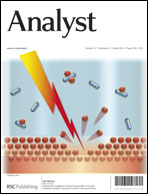Microcystin-LR and chemically degraded microcystin-LR electrochemical oxidation
Abstract
Microcystins (MCs) are cyclic hepatotoxic heptapeptides produced by certain strains of freshwater cyanobacteria toxic for humans and animals. The electrochemical behaviour of microcystin-LR (MC-LR) at a glassy carbon electrode (GCE) was investigated using cyclic voltammetry (CV), square wave voltammetry (SWV) and differential pulse voltammetry (DPV). The oxidation of MC-LR is a diffusion-controlled irreversible and pH-independent process that occurs with the transfer of only one electron and does not involve the formation of any electroactive oxidation product. Upon incubation in different pH electrolytes, homogeneous degradation of MC-LR in solution was electrochemically detected by the appearance of a new oxidation peak at a lower potential. The electrochemical behaviour of chemically degraded MC-LR is an irreversible, pH-dependent process, and involves the formation of two redox products that undergo reversible oxidation. The formation of degradation products of MC-LR was confirmed by HPLC with UV detection at room temperature. Experiments were also carried out in solutions containing constituent MC-LR amino acids, which enabled the understanding of the MC-LR electron transfer reaction and degradation. An oxidation mechanism for MC-LR is proposed.


 Please wait while we load your content...
Please wait while we load your content...